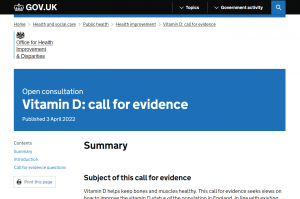Published on April 15, 2022
Video Friday: The UK Government says “We want to improve Vitamin D levels in the public”!
Key Points
- The Secretary of Health in the UK launched a call for evidence to improve vitamin D levels in the UK population while talking openly about vitamin D and racial health disparities due to vitamin D deficiency
- Most people do not get enough vitamin D, especially in the winter months
- It is ideal and necessary to check vitamin D levels and dose accordingly
 It’s Video Friday! Today we are featuring a video by Dr. John Campbell as he discusses a new call for evidence put out by the UK Government and Minster for Health, Sajid Javid, about the need to increase vitamin D levels. This call for evidence, published on April 3 of this year, will be open until May 15, 2022.
It’s Video Friday! Today we are featuring a video by Dr. John Campbell as he discusses a new call for evidence put out by the UK Government and Minster for Health, Sajid Javid, about the need to increase vitamin D levels. This call for evidence, published on April 3 of this year, will be open until May 15, 2022.
To participate, visit the official website here.
Watch the Video
Be sure to take note of the summary and added details below.
Video Summary with Additional Links
The Secretary of Health in the UK launched a call for evidence to improve vitamin D levels in the UK population while talking openly about vitamin D and racial health disparities due to vitamin D deficiency
As quoted, “Vitamin D is important for healthy bones, but older people and people from Asian and Black communities are more likely to have low levels. I’ve launched a new review looking at what more can be done to improve uptake and tackle health disparities.”
Most people are not getting enough vitamin D, and this is especially true during the winter months; consider the vitamin D levels recently reported from a group in North Dakota, where nearly half were below 20 ng/ml (50 nmol/L), 1 in 5 were below 10 ng/ml (25 nmol/L), and only one person had a level of at least 40 ng/ml (100 nmol/L)
The “Are you getting enough vitamin D?” infographic here is shared in the video
People with darker skin color are at a higher risk of vitamin D deficiency due to their need for more UVB exposure, compared to people of lighter skin, to make the same amount of vitamin D
As stated from the UK.gov website, This call for evidence invites respondents’ views on the following scientific areas:
- addressing health disparities related to accessing and consuming vitamin D
- improving population awareness of vitamin D
- improving awareness among health and care professionals of vitamin D
- improving vitamin D status through diet, including fortified foods and biofortification
- improving vitamin D status through dietary supplements, and increasing access to and availability of dietary supplements
While there is mention that a vitamin D intake of over 4000 IU per day may be toxic, it is extremely difficult to reach vitamin D toxicity, and 4000 IU per day may not be enough for many individuals
It is ideal and necessary to check vitamin D levels and dose accordingly
When taking higher doses of vitamin D, it is important to ensure you are getting enough vitamin K2 as well as magnesium, either from the diet or from supplements
How Are Your Vitamin D Levels, and How Much Vitamin D Do You Need? Find Out with Your Home Test!
 Having and maintaining healthy vitamin D levels and other nutrient levels can help improve your health now and for your future. Choose which additional nutrients to measure, such as your omega-3s and essential minerals including magnesium and zinc, by creating your custom home test kit today. Take steps to improve the status of each of these measurements to benefit your overall health. With measurement you can then determine how much is needed and steps to achieve your goals. You can also track your own intakes, symptoms and results to see what works best for YOU.
Having and maintaining healthy vitamin D levels and other nutrient levels can help improve your health now and for your future. Choose which additional nutrients to measure, such as your omega-3s and essential minerals including magnesium and zinc, by creating your custom home test kit today. Take steps to improve the status of each of these measurements to benefit your overall health. With measurement you can then determine how much is needed and steps to achieve your goals. You can also track your own intakes, symptoms and results to see what works best for YOU.
Enroll in D*action and Test Your Levels Today!






